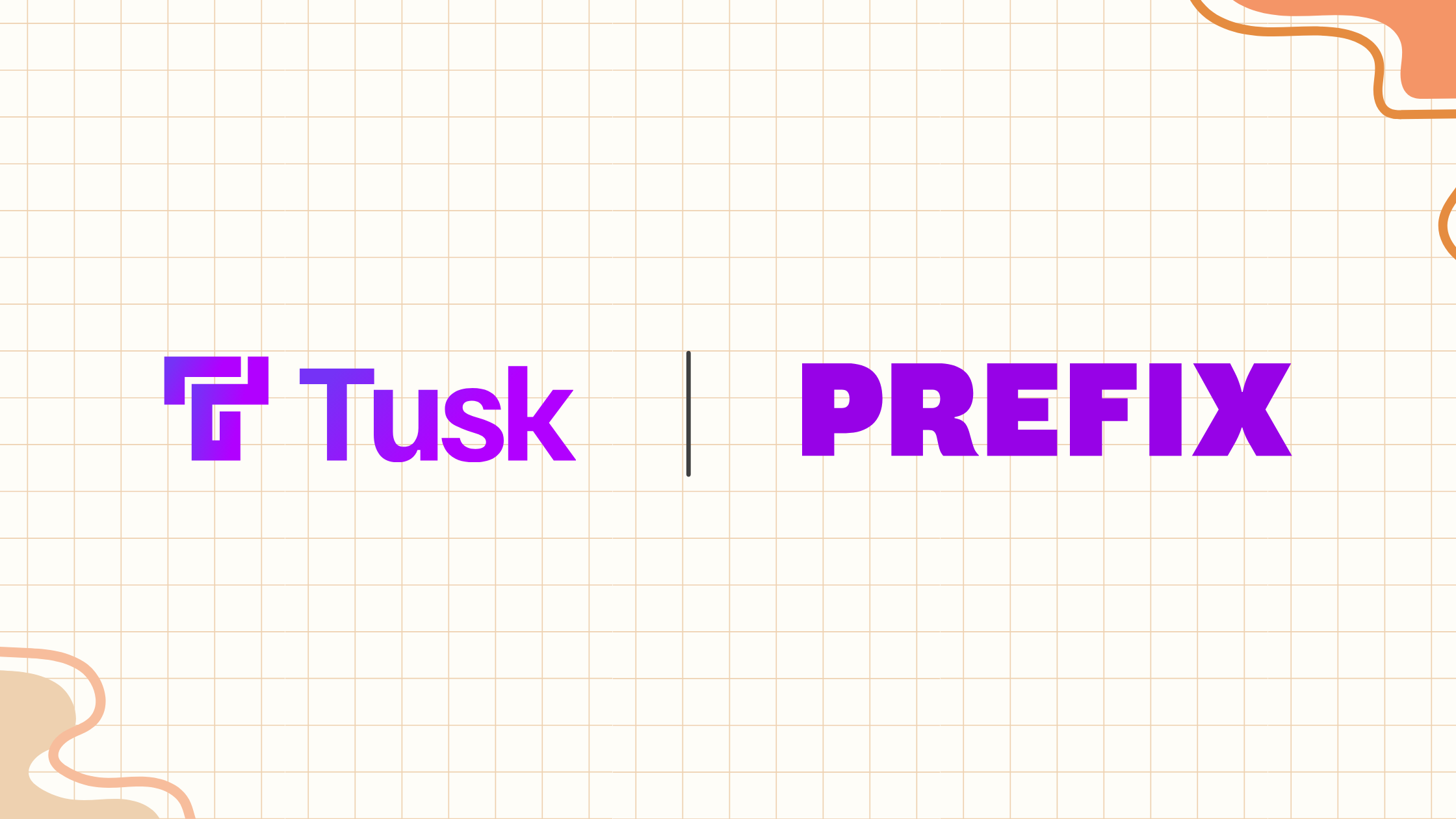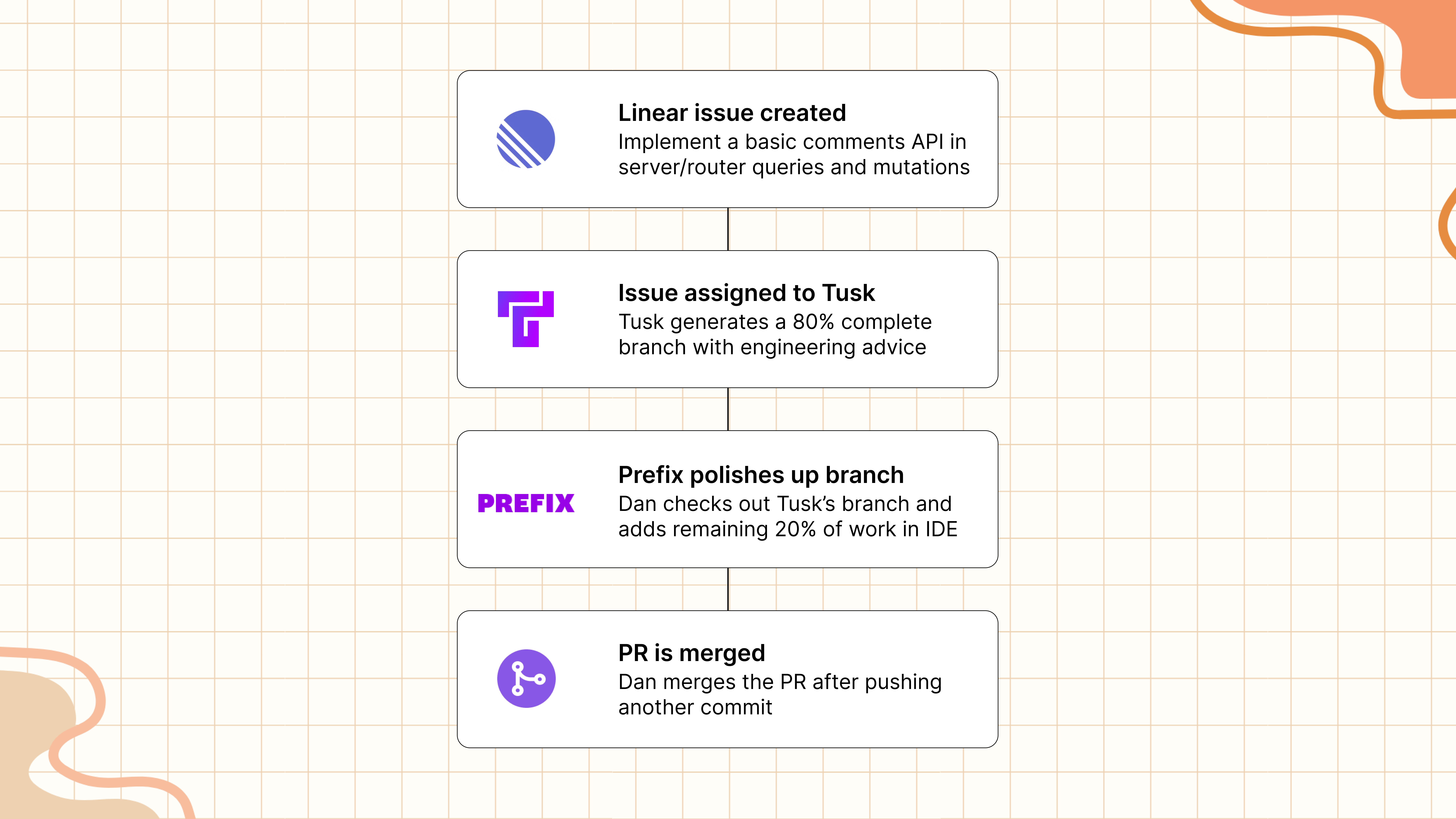- Published on
How Prefix uses Tusk to ship 2x faster
- Authors

- Name
- Marcel Tan
- @Marcel7an

Introduction
Prefix helps restaurant brands conduct repair and maintenance for mission-critical facilities. They make it easy for facility managers to get work done faster, at better prices and with higher quality from vetted vendors.
Prefix is a 14-person seed stage company with a small team of full-stack engineers. Software engineers at Prefix are product-minded engineers who care deeply about craft. They are expected to own feature development end to end because the team does not currently have product managers.
Challenges Faced
The Prefix team found themselves needing to boost their engineering productivity without hiring more people. Given that they had a lean engineering team, the two main obstacles facing them were:
- Menial frontend tickets requiring engineers to context-switch
- The cold start problem of taking on large, complex tickets from scratch
Dan García, founding Product Engineer at Prefix, found that context-switching for menial frontend tasks was causing him to lose focus time. This was time that could otherwise be spent on more meaningful work. He needed a way to enable non-engineering team members to make copy changes and polish their UI without over-involving engineers.
At the same time, Dan faced “coder’s block” when starting work on large, complex tickets as a product engineer who owned features end to end. The daunting nature of the work meant that there would be a lag time between him starting on a ticket and actually writing code in his IDE.
Tusk as a Solution
Now when working on a new feature, I start my day by firing up 5 Tusk issues while I work on something else or make my coffee. When I return, I have 5 Tusk PRs ready to go and it gets me super excited. Starting on a big, complex ticket can be difficult because of coder’s block. But if I have code generated by Tusk already, it gives me the momentum to get it done quicker.
– Dan García, Founding Product Engineer at Prefix
Tusk is an AI coding agent that writes, pushes, and tests code autonomously. When Dan first heard about Tusk, he saw potential for Tusk to act as a virtual team member whom he could offload routine coding tasks to. In the last 6 months, Prefix’s Tusk implementation has met those expectations and more.

Dan was drawn to the asynchronous nature of Tusk. Unlike other AI coding tools, Tusk could complete simple frontend tasks like copy changes and styling tweaks with no human intervention. This meant that Prefix’s engineers no longer had to be bothered by these mundane tasks.
Dan especially enjoyed using Tusk to generate multiple branches for larger tickets (i.e., tickets spanning both frontend and backend) at one go. Tusk’s code scaffolding for these tickets would often get 80% of the way to a mergeable state. Dan would then checkout each of the branches that Tusk created, push the remaining 20% of work, and merge the PRs.
He now leverages Tusk alongside an AI-powered code editor as a powerful, complementary pairing to ship twice as fast. He uses Tusk to generate the bulk of the code for large tickets, then jumps into his AI-powered code editor to refine the remaining bit to a mergeable state.
Improves Over Time
Tusk gets better over time in understanding our unique codebase context, so the code quality improves as we’re using it. It’s not like ChatGPT where I would need to spoon-feed it a complex prompt and copy-and-paste multiple files before asking it to generate code.
Prefix found that Tusk’s long term memory was one of its core strengths. Tusk would get better at writing code for their codebase the more that they used it. The AI agent would learn about Prefix’s code patterns and best practices from past PRs and code reviews, then accurately reference these insights when completing new tasks.
One example that Dan highlighted was how Tusk was smart enough to find an existing search bar component that he had entirely forgotten about when he had assigned Tusk to create a search bar for a table. Tusk reused the existing component to make the most elegant change—all without an engineer guiding it.
Results
I write less code but I ship more. This is my new flow and I don’t want to go back to how I was working before.
One major project that Dan took on recently was replacing a third-party chat component in Prefix’s app with a robust, in-house comment section. Initially scoped for 3 weeks, they completed it in 1.5 weeks with the help of Tusk.
Tusk helped break down the project into smaller tasks, handle migrations, and even surprised Dan by correctly implementing CRUD operations. While Tusk still helps Prefix out with automating away menial frontend work, it has become an integral part to shipping net new features faster.
In the last 2 months
| Shipping velocity | Cost savings | Return on Investment |
|---|---|---|
| 2x | $7.2k | 15x |
By embedding Tusk into their development workflow as an extra pair of coding hands, Prefix overcame engineering bandwidth constraints. Tusk's ability to generate high-quality code for larger tickets reduced cold start times and doubled their speed to market.
If you’d like to raise the quality bar of your product while shipping faster, book a demo with the Tusk founders.
If you’re a restaurant brand curious about offloading your facility maintenance to a trusted partner, reach out to jared@useprefix.com to learn more.